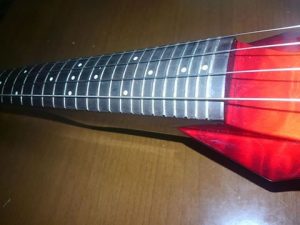Viper violinist Notes
(English follows Japanese)
2017.2.15.
ヴァイパーや琉球ヴァイオリンについて、ライヴのたびにいろいろなご質問をいただくので、少しずつでも答えてみたいとおもいます。
(^.^)
第1回はヴァイパーのフレットについて。

ヴァイオリンのフレットに関しては、実際に試したことも無いままにいろいろ言う人がとても多いのでなるべくわかりやすく書いたつもりです。
ご意見等あればぜひお聞かせください。
1.「フレットがあると弾きやすい(音程が取りやすい)のか?」
あっさりと言えばNO。
ヴァイパーにはギターのようなフレットがついています(無しも選べます)。
けれどこのフレットはギターのと違い、高さも低く、押さえる位置はその真上で、音程を定める機能はあまりありません。
指をずらせば音程もずれ、普通のヴァイオリンと同じく音程は無段階に変化します。
当然、音痴に弾くこともできますf(^-^;
また、演奏位置に構えてみると斜めから見ることになるので、正確にフレット上に指を乗せるのは案外難しいものです。
速い曲になるともちろん目視ではとうてい間に合いません。
つまりフレットレスのヴァイオリンで音程が取れなければフレット付ヴァイパーでも同じことなのです。
フレットがあるから簡単かも?
と期待した方は残念でした。
とまあ、夢の飛び道具とはいかないけれど
フレット付ヴァイオリンで音程練習をすれば
フレットレスのヴァイオリンの音程も取りやすくなるという利点があります。
フレットがそれぞれの指の位置を教えてくれるので
手をどの形にすれば4本の指をバランスよく使えるのか
半音程や全音程の指の開き具合はどのくらいなのか
ポジションが変わることで指の間隔がどのくらい変わるのか
他の弦との音程関係がどうなっているのか
といったことが目に見えてよくわかります。
こういう話をすると来るのが次の質問。
2.「フレットがあればそれに頼って、いつまでも音がわからないままなのではないか?」
結論から言えば、全くそんなことはありません。
道具は使い方ひとつなので、フレットで音程をよく聴いて、次に目を閉じてその音程をとれるかやってみるという使い方もできるので実はかなり効果的に練習できます。
なお、上記の通りこのフレットはあくまでも目安なので、ピッチの微調整能力は各人のこだわりでどこまででも鍛えられます。
3.「フレットがあると弾きにくくなる?(ヴァイオリンの感覚と違いすぎる?)」
両方弾いて思うことは、私にはフレット付もフレットレスもほとんど変わりません。
たまに訊かれる、ポルタメント奏法(指を滑らせる)でフレットに指がひっかかるようなことも特にありませんし、見て音程を取っているわけでも無いので、実のところフレットはほとんど意識していないのです。
指先がタコでガチガチになっている人は、フレットに指がひっかかると言っていました。
それはフレットが無い方が良いのか?
それとも、もっと柔らかく押さえた方が良いのか?
私は後者に一票。
フレットのせいで惑わされて指がずれる
という人もいました。
ちょっと言いにくいけれど、フレットレスでも音程ずれてますね…でも、きっと気がつかなかったのでしょう。
4.「では、練習のためのフレットなのか?」
フレット付アコースティックヴァイオリンは持っていないので、その利点はよくわかりません。
しかしながら、今のところエレクトリック・ヴァイオリンにはフレットがある方が良いように思います。
エレクトリック・ヴァイオリンは弦の振動をピックアップ(マイク)で電気信号に換えてアンプ付スピーカーで鳴らします。
この変換はまだまだ理想には遠く、よく使われるピエゾピックアップはアコースティックよりも鼻をつまんだような音に成りがちです。
そして、困るほどに伸び続ける開放弦の音と、指で押さえたくぐもった伸びの無い音との差がとても大きいのが難点。
ここにフレットを加えると押さえた弦の音色がクリアになって、開放弦と押さえた弦の響きが近づき…
あら不思議!
フレットがある方がアコースティックヴァイオリンの感覚に近い!
つまり、
「ヴァイパーのフレットは音程ではなく、音色のため!」
あくまで私個人の意見です♪
○Vol.2 ヴァイパーは電子楽器?電気楽器?
○ヴァイパー奏者の覚書 一覧
“Viper violinist Notes”
Vol.1 [A Fretted Violin]
February 15, 2017
During live performances, I often get asked a variety of questions regarding the Viper and Ryukyuish Violin. I’d like to gradually try to answer them.
The first question is regarding the Viper frets.
Regarding frets on a violin, many people who have never actually tried this type of instrument, will say many things. Therefore, I’ve done my best to talk about it in simple terms. If you have any opinions on the topic, I’d be happy to hear them.
1. [Does having frets make it easier to play?]
The short answer is, no.
Like the guitar, the Viper has frets. (You can also choose to have no frets on this instrument) However, what’s different from the guitar, is that the Viper frets are low. As well, in the case of the guitar, you put your finger between the frets, whereas with the Viper, the position to hold the string is directly on the fret. The Viper frets don’t really serve the function of setting the pitch.
On the Viper, if you move your finger, the pitch will shift. As with a regular violin, the pitch slides and changes steplessly. Of course, it’s possible to play the instrument like someone who is tone deaf.(^-^;
As well, if you hold the Viper in the playing position, you are looking at the frets from an angle, so it is unexpectedly difficult to put your fingers on the frets accurately.
When it comes to fast songs, it is impossible to rely on your eyes. You’ll never be in time. Basically, if you’re not able to get the pitch on a fretless violin, you won’t be able to get it on a fretted one.
Frets might make it easier? If you thought this, I’m sorry to disappoint you.
It might not shoot you straight to your dreams, but practicing getting the pitch with a fretted violin has it’s advantages. It will make it easier to get the pitch on a fretless violin afterwards. The frets will teach you many things. What is the best position of each finger, and the most balanced shape of your hand and four fingers? How wide is the finger spacing for diatonic or chromatic notes? How much does the finger spacing change as you shift up the neck of the violin? What is the pitch relationship between other strings? You will clearly see these things.
Discussing these things brings up another question.
2. [If you have frets, don’t you rely on them, never really understanding or being aware of the sound you’re making?]
I’ll jump right to the conclusion. No, that’s not the case at all.
The frets can be used as a practice tool. First listen carefully to the pitch while watching the frets. Then try closing your eyes, and see if you can get the same pitch. This practice is actually very effective.
As mentioned above, the frets are just a guide, and can help you train your ability to accurately find the pitch. Frets will help you fine tune your abilities as far as you like.
3. [Is it hard to play with frets? (Is it too different from the feeling of a regular violin?)]
Having played both, I can say that fretted and fretless are almost the same in terms of difficulty for me.
I sometimes get asked, “When playing portamento, (the technique of sliding the finger along the neck of the violin) don’t your fingers get caught on the frets?”
To answer, not really. Also, since I don’t find the pitch by looking with my eyes, I am almost unaware of the frets.
Someone with calluses on his fingertips said that his fingers get caught on the frets. “In this case, would it be better to have no frets? Or should we press the strings more gently?”
I would recommend the latter. Try pressing the strings more gently.
Another person commented, “The frets mislead me and my fingers are off pitch.”
It’s hard for me to say this, but his tuning on a fretless violin is also off…although he probably doesn’t notice it.
4. [So, the frets are just for practice?]
Well, I don’t have an acoustic violin with frets, so I’m not sure what the benefits of it would be. However, for now, I think it’s better for electric violins to have frets.
On the electric violin, the vibration of the strings are converted, by means of a pickup (microphone) into an electric signal. This electric signal then sounds through an amplification device, a speaker.
This conversion of the sound is still far from ideal, and the commonly used piezo pickups tend to produce a more nasal rather than acoustic sound.
One of the real difficulties is the significant difference between the expansive sound of the open strings, and the slightly muffled, non-expansive sound of the closed strings. (the strings pressed down with the fingers) With the help of the frets, the sound of the closed string (pressed string) becomes clearer, and sounds closer to the resonant sound of an open string. How mysterious! Having frets brings the sound closer to that of an acoustic violin!
Basically, [The frets on the Viper are not for pitch. They are for tone color!]
Of course, this is just my personal opinion.♪





